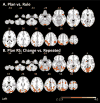Contributions of the parietal cortex to increased efficiency of planning-based action selection
- PMID: 28438707
- PMCID: PMC5651213
- DOI: 10.1016/j.neuropsychologia.2017.04.024
Contributions of the parietal cortex to increased efficiency of planning-based action selection
Abstract
Response selection is foundational to adaptive behavior, and considerable attention has been devoted to investigating this behavior under conditions in which the mapping between stimuli and responses is fixed. Results from prior studies implicate the left supramarginal gyrus (SMg), premotor and prefrontal cortices, as well as the cerebellum in this essential function. Yet, many goal-directed motor behaviors have multiple solutions with flexible mappings between stimuli and responses whose solutions are believed to involve prospective planning. Studies of selection under conditions of flexible mappings also reveal involvement of the left SMg, as well as bilateral premotor, superior parietal cortex (SPL) and pre-supplementary motor (pre-SMA) cortices, along with the cerebellum. This evidence is, however, limited by exclusive reliance on tasks that involve selection in the absence of overt action execution and without complete control of possible confounding effects related to differences in stimulus and response processing demands. Here, we address this limitation through use of a novel fMRI repetition suppression (FMRI-RS) paradigm. In our prime-probe design, participants select and overtly pantomime manual object rotation actions when the relationship between stimuli and responses is either flexible (experimental condition) or fixed (control condition). When trials were repeated in prime-probe pairs of the experimental condition, we detected improvements in performance accompanied by a significant suppression of blood oxygen-level dependent (BOLD) responses in: left SMg extending into and along the length of the intraparietal sulcus (IPS), right IPS, bilateral caudal superior parietal lobule (cSPL), dorsal premotor cortex (dPMC), pre-SMA, and in the lateral cerebellum. Further, region-of-interest analyses revealed interaction effects of fMRI-RS in the experimental versus control condition within left SMg and cerebellum, as well as in bilateral caudal SPL. These efficiency effects cannot be attributed to the repetition of stimulus or response processing, but instead are planning-specific and generally consistent with earlier findings from conventional fMRI investigations. We conclude that repetition-related increases in the efficiency of planning-based selection appears to be associated with parieto-cerebellar networks.
Keywords: Action selection; fMRI repetition suppression.
Copyright © 2017 Elsevier Ltd. All rights reserved.
Conflict of interest statement
Figures






Similar articles
-
The human prefrontal and parietal association cortices are involved in NO-GO performances: an event-related fMRI study.Neuroimage. 2002 Nov;17(3):1207-16. doi: 10.1006/nimg.2002.1198. Neuroimage. 2002. PMID: 12414261
-
The human dorsal stream adapts to real actions and 3D shape processing: a functional magnetic resonance imaging study.J Neurophysiol. 2008 Nov;100(5):2627-39. doi: 10.1152/jn.01376.2007. Epub 2008 Sep 3. J Neurophysiol. 2008. PMID: 18768646
-
A functional MRI study of motor dysfunction in Friedreich's ataxia.Brain Res. 2012 Aug 30;1471:138-54. doi: 10.1016/j.brainres.2012.06.035. Epub 2012 Jul 3. Brain Res. 2012. PMID: 22771856
-
Top-down and bottom-up attention to memory: a hypothesis (AtoM) on the role of the posterior parietal cortex in memory retrieval.Neuropsychologia. 2008;46(7):1828-51. doi: 10.1016/j.neuropsychologia.2008.03.022. Epub 2008 Apr 8. Neuropsychologia. 2008. PMID: 18471837 Review.
-
The interaction of attention and action: from seeing action to acting on perception.Br J Psychol. 2010 May;101(Pt 2):185-206. doi: 10.1348/000712609X458927. Epub 2009 Jul 16. Br J Psychol. 2010. PMID: 19619392 Review.
Cited by
-
Selective effects of psychosocial stress on plan based movement selection.Sci Rep. 2022 Mar 30;12(1):5401. doi: 10.1038/s41598-022-09360-0. Sci Rep. 2022. PMID: 35354889 Free PMC article.
-
Rapid Cortical Plasticity Induced by Active Associative Learning of Novel Words in Human Adults.Front Neurosci. 2020 Sep 11;14:895. doi: 10.3389/fnins.2020.00895. eCollection 2020. Front Neurosci. 2020. PMID: 33013296 Free PMC article.
-
Effects of age, sex, and puberty on neural efficiency of cognitive and motor control in adolescents.Brain Imaging Behav. 2020 Aug;14(4):1089-1107. doi: 10.1007/s11682-019-00075-x. Brain Imaging Behav. 2020. PMID: 30903550 Free PMC article.
-
Contributions of the Primary Sensorimotor Cortex and Posterior Parietal Cortex to Motor Learning and Transfer.Brain Sci. 2024 Nov 26;14(12):1184. doi: 10.3390/brainsci14121184. Brain Sci. 2024. PMID: 39766383 Free PMC article.
-
Action and semantic tool knowledge - Effective connectivity in the underlying neural networks.Hum Brain Mapp. 2018 Sep;39(9):3473-3486. doi: 10.1002/hbm.24188. Epub 2018 Apr 26. Hum Brain Mapp. 2018. PMID: 29700893 Free PMC article.
References
-
- Andersson JLR, Jenkinson M, Smith SM. Non-linear optimisation 2007
-
- Bálint D. Seelenlähmung des “Schauens”, optische Ataxie, räumliche Störung der Aufmerksamkeit. European Neurology. 1909;25:51–66. 51–66.
-
- Beckmann C, Smith S. Probabilistic independent component analysis for functional magnetic resonance imaging. IEEE Trans Med Imaging. 2004;23:137–152. - PubMed
-
- Beckmann CF, Jenkinson M, Smith SM. General multilevel linear modeling for group analysis in FMRI. Neuroimage. 2003;20:1052–1063. - PubMed
MeSH terms
Substances
Grants and funding
LinkOut - more resources
Full Text Sources
Other Literature Sources

